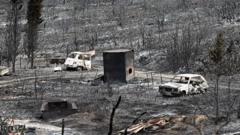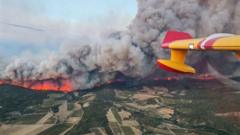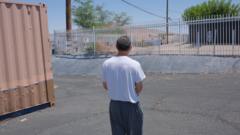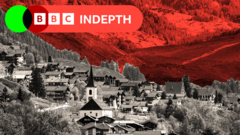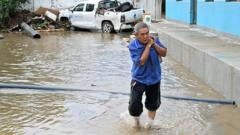As the Canyon Fire rapidly expands due to extreme heat and dry conditions, thousands of residents in Southern California are facing mandatory evacuations.
Canyon Fire Sparks Mass Evacuations in Southern California
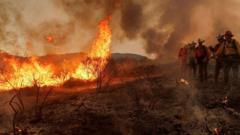
Canyon Fire Sparks Mass Evacuations in Southern California
Rapidly spreading wildfire threatens communities as emergency services respond.
The fire, which ignited along the border of Ventura and Los Angeles counties on Thursday afternoon, has grown alarmingly from 30 acres to nearly 5,000 acres by Friday morning. The Ventura County Fire Department reported that over 2,700 residents have been ordered to evacuate, while an additional 14,000 have received evacuation warnings. As of Friday, about 25% of the fire's perimeter has been contained, but officials remain on high alert.
Intense heat, with temperatures expected to reach 100°F (37.7°C), is complicating firefighting efforts and increasing the urgency of evacuation orders. The city of Santa Clarita, located near the blaze, has seen officials urging residents to avoid fire-affected areas. “The #CanyonFire is spreading fast under extreme heat & dry conditions near Ventura–LA County line,” stated LA County Supervisor Kathryn Barger on social media. Residents in areas like Santa Clarita, Hasley Canyon, and Val Verde have been reminded to take evacuation orders seriously, emphasizing the importance of leaving immediately if instructed by first responders.
As of Thursday evening, there were no reported injuries or damages to homes, according to the LA County Fire Department. However, the Canyon Fire is one part of a larger crisis, with several wildfires currently active throughout California. The Gifford Fire, which has consumed almost 100,000 acres in the San Luis Obispo and Santa Barbara counties, is the largest blaze in the state. Wildfires in California have become more frequent, exacerbated by climate change which is creating hotter and drier conditions that prolong fire seasons and intensify their destructive impacts.
This year alone has seen tragedies linked to wildfires, with the Eaton Fire claiming at least 31 lives and destroying numerous structures earlier. A disturbing study indicates more than 400 indirect deaths associated with wildfires in Los Angeles, reiterating the dire consequences of these increasingly common disasters.
California is facing ongoing challenges as wildfires become a more frequent and devastating reality, prompting urgent calls for awareness and action among residents.
Intense heat, with temperatures expected to reach 100°F (37.7°C), is complicating firefighting efforts and increasing the urgency of evacuation orders. The city of Santa Clarita, located near the blaze, has seen officials urging residents to avoid fire-affected areas. “The #CanyonFire is spreading fast under extreme heat & dry conditions near Ventura–LA County line,” stated LA County Supervisor Kathryn Barger on social media. Residents in areas like Santa Clarita, Hasley Canyon, and Val Verde have been reminded to take evacuation orders seriously, emphasizing the importance of leaving immediately if instructed by first responders.
As of Thursday evening, there were no reported injuries or damages to homes, according to the LA County Fire Department. However, the Canyon Fire is one part of a larger crisis, with several wildfires currently active throughout California. The Gifford Fire, which has consumed almost 100,000 acres in the San Luis Obispo and Santa Barbara counties, is the largest blaze in the state. Wildfires in California have become more frequent, exacerbated by climate change which is creating hotter and drier conditions that prolong fire seasons and intensify their destructive impacts.
This year alone has seen tragedies linked to wildfires, with the Eaton Fire claiming at least 31 lives and destroying numerous structures earlier. A disturbing study indicates more than 400 indirect deaths associated with wildfires in Los Angeles, reiterating the dire consequences of these increasingly common disasters.
California is facing ongoing challenges as wildfires become a more frequent and devastating reality, prompting urgent calls for awareness and action among residents.




